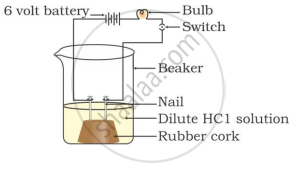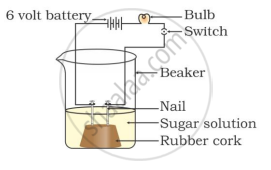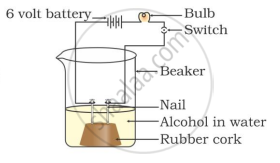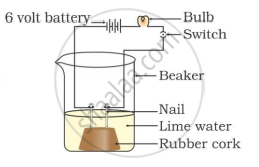Advertisements
Advertisements
Question
Salt A commonly used in bakery products on heating gets converted into another salt B which itself is used for the removal of hardness of water and a gas C is evolved. The gas C when passed through lime water, turns it milky. Identify A, B and C.
Solution
The salt A is sodium hydrogen carbonate (baking soda) and is commonly used in bakeries as a constituent of baking powder. Upon heating, it changes to sodium carbonate B and evolves carbon dioxide gas C.
`underset("'A'")(2"NaHCO"_3) overset("heat")(->)underset("'B'")("Na"_2"CO"_3) + underset("'C'")("CO"_2)`
Sodium carbonate removes hardness from water while CO2 gas turns lime water milky.
APPEARS IN
RELATED QUESTIONS
While diluting an acid, why is it recommended that the acid should be added to water and not water to the acid?
What colour do the following indicators turn when added to a base or alkali (such as sodium hydroxide)?
(a) methyl orange
What colours do the following indicators turn when added to an acid (such as hydrochloric acid)?
methyl orange
You have been provided with three test-bubes. One of these test-tubes contains distilled water and the other two contain an acidic and a basic solution respectively. If you are given only blue litmus paper, how will you identify the contents of each test-tube?
What is common in all the water soluble bases (or alkalis)?
Vinay observed that the stain of curry on a white shirt becomes reddish-brown when soap is scrubbed on it, but it turns yellow again when the shirt is washed with plenty of water. What might be the reason for his observation?
- Soap is acidic in nature
- Soap is basic in nature
- Turmeric is a natural indicator which gives reddish tinge in bases
- Turmeric is a natural indicator which gives reddish tinge in acids
In which of the following setups would the bulb glow?
Which of the following phenomena occur when a small amount of acid is added to water?
- Ionisation
- Neutralisation
- Dilution
- Salt formation
Identify the correct representation of reaction occurring during chloralkali process
- A compound 'A' with a molecular formula of \[\ce{C2H4O2}\] reacts with a base to give salt and water. Identify 'A', state its nature and the name of the functional group it possesses. Write chemical equation for the reaction involved.
- When the above stated compound 'A' reacts with another compound 'B' having molecular formula \[\ce{C2H6O}\] in the presence of an acid, a sweet smelling compound is 'C' formed.
- Identify 'B' and 'C'.
- State the role of acid in this reaction.
- Write chemical equation for the reaction involved.




